Covid 19 - How it affects IT
By Biman PathirageIntroduction (Or is one needed at all?)
If there’s one word that every human being on the earth has heard about within the past year, it is Covid. The impact of this is so large that every country in the globe is going through the roughest patch in their recent medical and in turn, economical history. Almost all the businesses, let it be restaurants, car sales, retail shops, bars, automotive repair centers, gas stations, grocery stores, hotels, bookstores, gyms, clothing stores (‘Awurudu’ season aside in Sri Lanka) and salons, are affected by this pandemic going around the world. So, is the IT sector an exception? The answer is no. But if someone asks how impactful was Covid 19 to the IT sector, you could argue that it was one of the least hit businesses around the globe. But it’s also worth noting that some IT companies working in the travel or tourism industry have been hard hit by the pandemic in its early stages. This has been a direct result of flight and hotel industry being collapsed due to limited travel and travel bans.
In this blog post we will have an insight on how the IT sector behaved under covid 19 pandemic pressure and how the future of the industry will be shaped..
The WFH dilemma
The main change that was brought over to the IT companies by the pandemic was working remotely from home. Almost all the IT companies over the world now expects their employees to work from home unless in some exceptional cases. It is not new to the industry, but the percentage of doing so has increased dramatically over the last year.
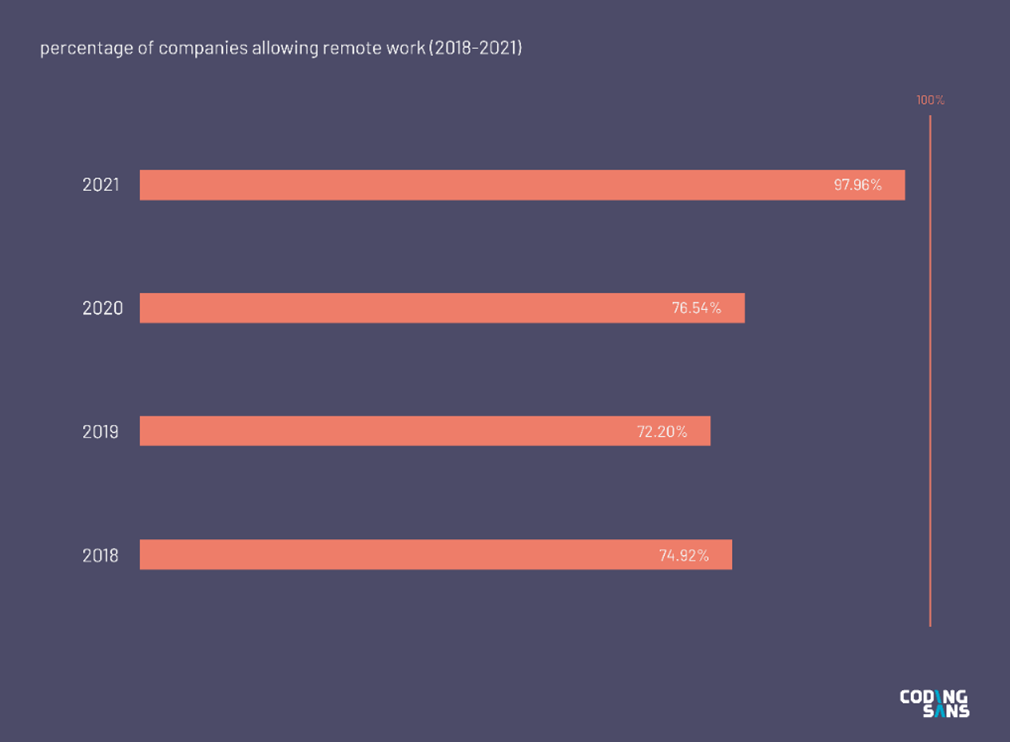
And the most important thing is that working remotely is here to stay forever with most companies. More than half of the companies plan on working from home fully or as a hybrid model where some employees are permitted to work from home, and some are required to come to office on a roster basis.
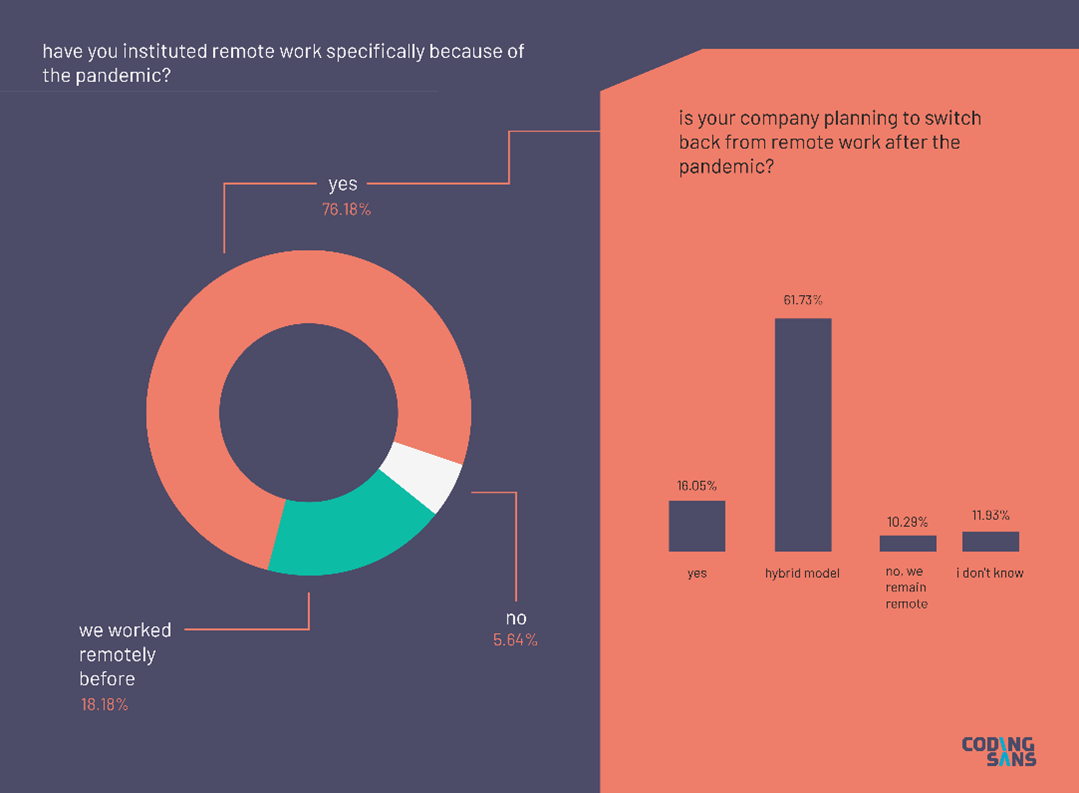
How it panned out for the techies
Now that we know most companies and employees will have to carry on with these remote working environments for god knows how long, let’s investigate some of the pros and cons faced by them while doing so.
The good -
-
Saves a lot of time and money for both parties -
A lot of employees are saving a significant amount of time (and money) since their transportation to and from the workplace is now not required. Pre pandemic, an average worker spent roughly about 2-3 hours on the road per day, stuck in traffic while trying to reach their workplace. This is a huge wastage of time and money for that individual and in turn for the whole country. Additionally, most employees stay in boarding places and buy meals from outside, which adds to the costs while working in an office. But with the WFH structure, these issues are minimized, and the saved time can be spent for more project work or to spend with family.
Companies too, have been saving a lot of money through reducing their workspace infrastructure and internet expense cut downs. They also don’t have to provide transportation or meals to employees anymore, and the lights (and some air conditioners) are not running throughout the day inside the remaining buildings.
-
Increased productivity
Employees working in their own in a quiet environment without all the office chatter and unwanted meetings might make be more productive. It’s also helped that the employees can take a break whenever they want and restart work as they wish.
-
More flexibility
Employees have a more flexible timetable since they save a lot of time specially from less traveling. They could go to the grocery shop nearby in the morning and quickly come back within half an hour before starting work, whereas two years back it would have taken them more than an hour in the morning to travel to office alone. In the lunch hour they could put the clothes in the washing machine or have a bath and freshen up and still save some time. This means a better work life balance for the employee IF he manages everything perfectly. If not, check out what would happen in the bad points on work life balance.
The Bad -
-
Work life balance – Could turn ugly if not managed properly
Some employees complain that WFH has made a separate personal life from work pretty difficult, mostly because there could be distractions while working from home which would have been not there had they worked at the office. These distractions in turn would make the employee to work overtime to compensate for the lost time and in turn disrupt his/her personal life out of office hours. These distractions are also not beneficial for the health of the company itself, as employees might not be focused on their work.
But if the employee can manage the WFH model properly, he/she should be able to overcome this issue. It’s pretty simple, you just have to have a dedicated working setup in your home and let your family members know that although you are home, you are working and would be better off without any distractions during that time.
-
Communication difficulties -
The communication between project teams has been asynchronous since the start of this WFH model and as a result, the overhead is much more than when working and meeting on site. This has also made the employees a wee bit stressful since there is no one to walk over and talk to when they come across a small technical issue or when they need a small rest. Basically, less teatime chit chats are not a good thing going forward for the employees, but they will have to deal with it until the end of this pandemic.
This could in turn lead to mental issues, stress and burnout and it should be the primary responsibility of managers and HR staff to make sure that their employee’s mental health is stable at all times and do whatever they can to avoid unwanted stress of their employees.
-
Less exercise could mean more health issues
Many employees would use public transportation to travel if the offices were open. And it makes them walk a lot. Working from home only makes them walk from the bedroom to their office room to the kitchen and back. This is a major concern for the health of the individual. If they were in the office, they would have walked up and down the stairs to meet a coworker or to the kitchen coffee machine or go out to the nearby café for lunch, all of which would help burn some calories. Working from home will not burn those calories unless people add exercises to their daily routine.
And the ugly -
-
Difficult to manage and maintain accountability of employees
For some organizations, it has been really hard to keep track of what the employees are doing while they are working from home. Some employees tend to misuse the luxuries of working from home and in turn lose their productivity. This has been the main disadvantage of WFH for the companies. If the employees don’t have the self-discipline to adhere to company regulations and work, this model could not work out for them at all.
-
Companies asking the employees to work around the clock
Some companies also have misused the WFH concept and asked employees to work throughout the whole day, thus reducing time for the employees to stay with their family although they are home. Some employees have claimed in researches that they spent more family time pre pandemic than at present since they didn’t have to work once they got home in the past. If they were at office, they would only work office hours, but now that they have access to office work from home, employers have tried to take advantage of this.
This has resulted in more stress and in turn loss of productivity again. So, there’s a clear risk of overworking which is not good for the health of the individuals as well. This can lead to burnout and increased work-related stress.
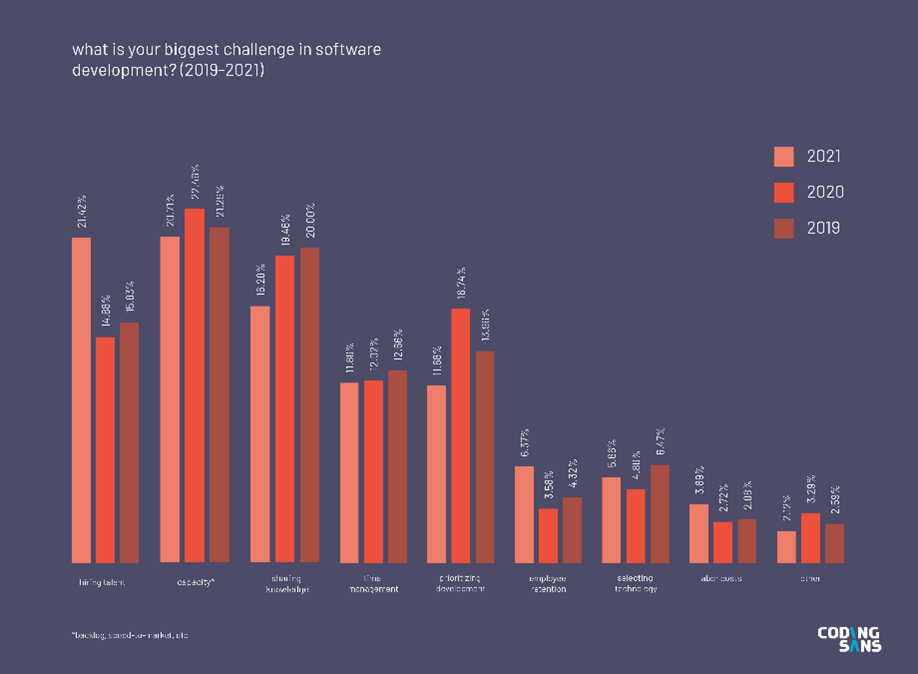
Downsizing – Was it really necessary?
As stated earlier, the tourism related companies were one of the hardest affected in the IT industry. But such companies too were able to find redemption through new customer requirements based on the Covid 19 pandemic. For an example, companies doing flight and hotel reservation management systems got new customer requirements to develop quarantine packages and add them to their hotel reservation system. So, it is evident that the industry will find ways to get up somehow from this pandemic. But truth be spoken, a few unfortunate companies have had to downsize as a result of this crisis as well.
But looking at the following charts (based on a study done by the (citing https://codingsans.com/), it is evident that not a lot of companies had to downsize as a direct result of the pandemic. And about a fourth of all companies have complained about the pandemic affecting them negatively while the other three fourths have admitted that the effect was either not significant or the negative and positive points had evened out. Even if we take our own company for an example, although we had to go through a rough patch at the very start, we have not downsized and rather have even been able to recruit newcomers amid the pandemic, which is a big positive sign. So overall, it’s safe to say that although the software industry didn’t remain unharmed by the pandemic, it seems to be in pretty good shape at the moment.
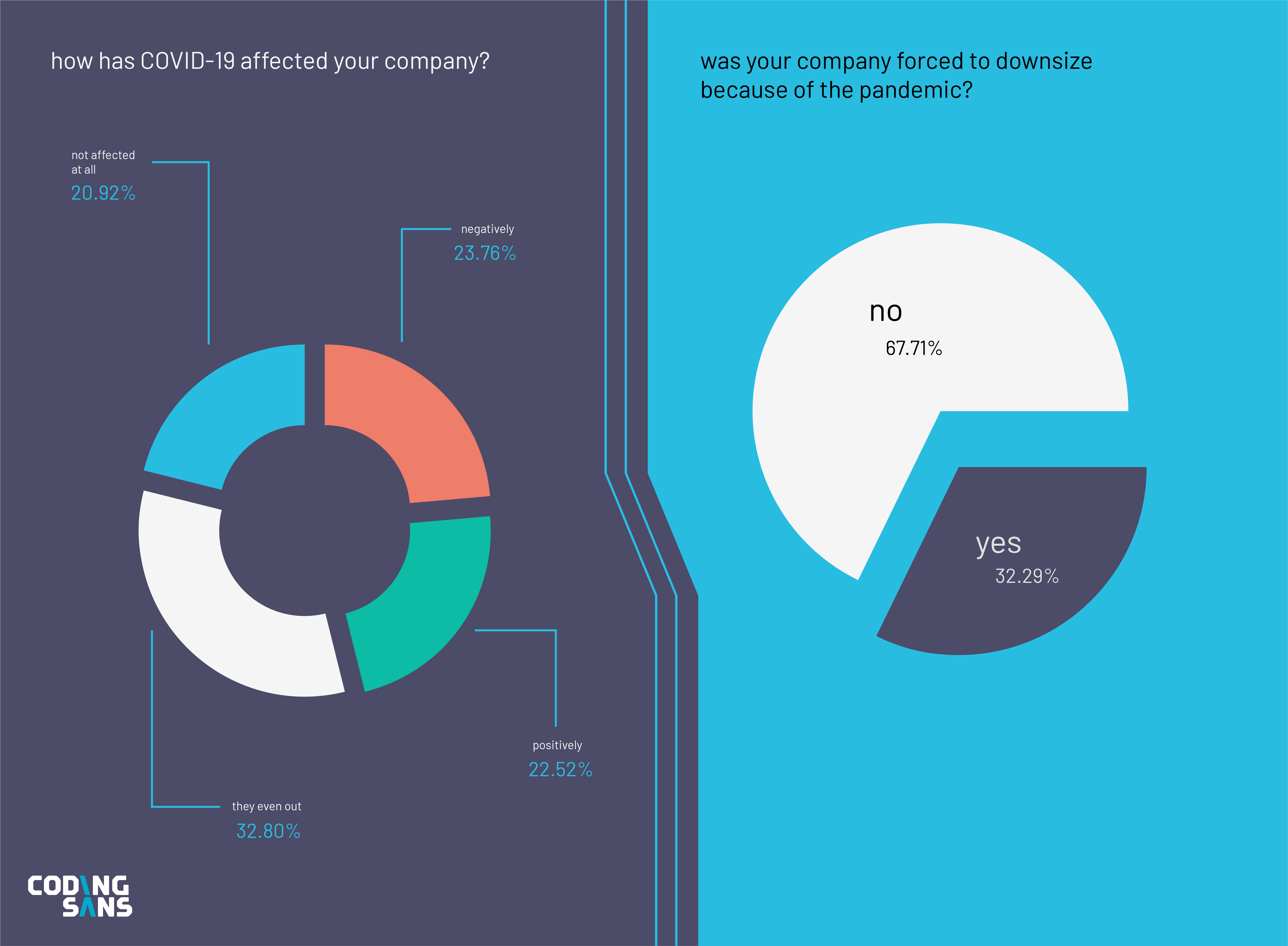
Not everyone has been losing amid the pandemic
It could be argued that covid is one ‘virus’ which has affected most of IT firms in a positive way. It is expected for IT companies to have an enormous market boom from US$ 131 Billion in 2020 to US$ 295 in the next five years (citing https://www.marketdataforecast.com). This is mainly because the shifting of people and governments more and more towards technology and IoT devices as long-time solutions because of the pandemic.
Following are few examples of how the technology has helped tackling down this crisis and in turn benefited the IT world and its inhabitants from the ongoing pandemic.
- Police in China are using drones attached with thermal sensors to identify the symptoms for coronavirus and get immediate medical help for people in crowded areas.
- The Australian government is using chat bots in public places to provide people with correct Covid information and stop spreading of false information which could mislead the public.
- In South Korea, a smart phone app has been developed which would enable the Covid patients to work closely with their coworkers.
- In China, a 5G powered system was introduced to enable the consultations and diagnoses of people affected by the virus by connecting the physicians at a single hospital to multiple other hospitals so that diagnosis and treatment could be done faster.
- The gaming company PUBG has gained a market value of over USD$ 100 billion during the crisis as more and more people are locked down and are getting in to gaming more often.
More classic examples right under our nose
- In Sri Lanka, the Keells supermarket chain saw a huge demand for online shopping in the lockdown period and their IT section was more than successful in delivering one of the best online grocery sites in the country within just a few months, beating other supermarket chains to online shopping by a large margin. And now their website has a very high ROI rate, with most people feeling safer and easier to order all their grocery needs in one place.
- ‘PickMe’ was one of the best examples of Sri Lanka which boomed in success with the Covid 19 pandemic, who started delivery of various grocery items and household goods to locked down areas of the island for a small delivery fee (citing http://www.colombopage.com).
- ‘oDoc’ is another classic Sri Lankan example which started hosting video appointments between doctors and patients and started delivering medicine which could be ordered through their website or the app, to locked down areas. This company saw a 374% increase in new customer registrations during the lockdown period in March 2020 growing at 10% per day. They have become the official telemedicine provider for the government of Sri Lanka as well (citing http://www.colombopage.com)
- A free app ‘Suwapetha’ has been developed by the Epidemiology Unit of the Western Provincial Ministry of Health and WHO Sri Lanka which tracks the nearest detected Covid patients to your current location and provides fingertip access for the contact details of the local Public Health Authorities the location of and directions to the nearest hospital and the nearest pharmacy, at any given location, a link to direct-dial “Suwasariya - 1990” Ambulance service and details of other emergency numbers.
All these are examples of how the IT industry is helping people around the world to cope with the pandemic, and in turn helping the IT employees to not lose their jobs even in a great recession period. So, it’s safe to say that the IT sector is safe from the crisis. For now.
The Verdict
The primary target for any IT company during these hard times should be to grab the opportunity when presented and build on the current situation to make sure that the business continuity is not affected. It may not be on one of the company’s specialized areas, but they have to try as there are numerous opportunities rising which could help tackle down the virus and generate more job opportunities.
One such area that will need more and more involvement by the IT sector is online learning platforms. With most schools and universities around the globe still not fully opened, moving into online learning has been the normalcy throughout the past few months (And some governments have long term plans to continue doing so). So, it presents a good opportunity for the IT companies to get involved in e-learning projects and make sure the demand is met. It was observed that the Online Learning Platform usage has gone up by 200% in this pandemic duration (citing https://research.g2.com)
Furthermore, since more and more employees are starting to work from home and mostly do so using their own devices, cybersecurity issues might be a bigger problem than before. Therefore, companies might need to take necessary steps to mitigate such risks in the future. As much as we talk about companies having to reduce their capacities due to fair reasons, it’s also important for companies stop unwanted and unfair salary cuts as a result of the pandemic, since it has been observed that people tend to leave their jobs for such reasons. And it goes without saying that employees need to understand the work from home situation and get used to it, and not misuse this model for their personal gains.
So, it can be concluded that the covid 19 pandemic has affected the IT industry far less than it has done for other businesses in the world. As the image below depicts, the biggest gainers in the pandemic have all been related to IT sector.
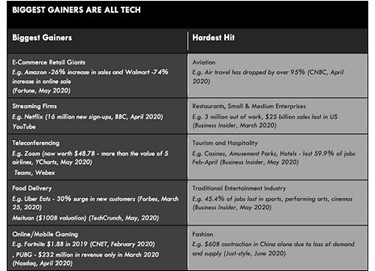
It’s now time to get up from the ashes and rebuild the hard-hit areas in the industry. Employers need to start empowering and motivating the employees to work for the betterment of the companies along with helping them keep a sound head without letting the pandemic and its effects result in their mental stress. After all, happy employees mean increased productivity, and in turn happy customers!
As much as working from home seems to be stressful and less ‘socio-friendly’, we might have to continue this way for the foreseeable future. Stay safe, adhere to health guidelines and always look in to and be connected with your fellow employees although you are working from home. Remember this one thing: None of us are safe until everyone is safe.

